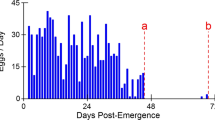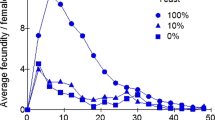Summary
The ovarian state of Drosophila melanogaster females from a wild population in the south of France was studied by immediate dissection, in the field, during two different periods in the year: early in June and at the end of September. It was compared with either the reproductive capacities of aliquot females kept in laboratory conditions or the reproductive potential of the first laboratory generation.
Among the wild flies, about 20% were young (less than 24 h). 85 to 90% of all females were inseminated and virgins were found among the youngest ones.
In the field, the vitellogenetic activity appeared to be very low and noncontinuous. Females with active vitellogenesis were fairly rare but about 60% of the females presented eggs in retention in the ovaries and 50% had a fertilized egg waiting in the uterus. All these observations showed that fecundity in the field was certainly low.
When wild females were studied in the laboratory, their daily egg production was relatively high, more than 50 eggs per day per female. This production was stimulated by insemination and decreased with adult population density.
Daughter females reared in the laboratory were bigger, had more numerous ovarian tubes than their mothers (an average of 50 instead of 32), and their daily egg production was very high. However the daily overiole production in these two groups was very similar.
The genetic reproductive potential of this natural French population seems to be very high but, under natural life conditions, this potential is not expressed. Wild flies do not seem to give priority to their reproductive effort but to individual survival and activity.
Similar content being viewed by others
References
Allemand, R., Cohet, Y., David, J.: Increase in the longevity of adult Drosophila melanogaster kept in permanent darkness. Exptl. Geront. 8, 279–283 (1973)
Anxolabehere, D., Periquet, G.: Resistance des imagos aux basses températures chez Drosophila melanogaster. Bull. Soc. Zool. Fr. 95, 61–70 (1970)
Ayala, F.J.: Dynamics of populations. I. Factors controlling population growth and population size in Drosophila serrata. Am. Nat. 100, 333–344 (1966)
Ayala, F.J.: Dynamics of populations. II. Factors controlling population growth and population size in Drosophila pseudoobscura and in Drosophila melanogaster. Ecology (USA) 48, 67–75 (1967)
Bakker, K.: An analysis of factors which determine success in competition for food among larvae of Drosophila melanogaster. Arch. Néerl. Zool. 14, 200–281 (1961)
Bakker, K.: Selection for rate of growth and its influence on competitive ability of larvae of Drosophila melanogaster. Neth. J. Zool. 19, 541–595 (1969)
Barbault, R.: La notion de stratégie démographique en écologie. Bull. Ecol. 7, 373–390 (1976a)
Barbault, R.: Contribution à la théorie des stratégies démographiques: recherches sur leur déterminisme écologique chez les lézards. Bull. Soc. Zool. Fr. 101, 671–693 (1976b)
Barker, J.S.F.: Adult population density, fecundity and productivity in Drosophila melanogaster and Drosophila simulans. Oecologia (Berl.) 23, 83–92 (1973)
Begon, M.: Temporal variations in the reproductive condition of Drosophila obscura Fallen and D. subobscura Collin. Oecologia (Berl.) 23, 31–47 (1976)
Begon, M.: The effective size of a natural Drosophila subobscura population. Heredity 38, 13–18 (1977)
Boesiger, E.: Estimation globale de l'âge des femalles de Drosophila melanogaster capturées dans des populations naturelles. C.R. Soc. Biol. 162, 358–361 (1968)
Boulétreau-Merle, J.: Influence de l'accouplement sur la physiologie reproductrice des femelles de Drosophila melanogaster (Meig.). Fonctions modifiées, nature des stimulations reçues et relais physiologiques mis en jeu. Thèse Doctorat d'Etat, Lyon (1975)
Cohet, Y.: Epigenetic influences on the life span of the Drosophila: existence of an optimal growth temperature for adult longevity. Exptl. Geront. 10, 181–184 (1975)
David, J.: Le nombre d'ovarioles chez Drosophila melanogaster: relation avec la fécondité et valeur adaptative. Arch. Zool. Exp. Gén. 111, 357–370 (1970)
David, J., Clavel, M.F.: Interaction entre le génotype et le milieu d'élevage. Conséquences sur les caractéristiques du développement de la Drosophile. Bull. Biol. Fr. Belg. 99, 369–378 (1965)
David, J., Clavel, M.F.: Influence de la température subie au cours du développement sur divers caractères biométriques des adultes de Drosophila melanogaster Meigen. J. Insect Physiol. 13, 717–729 (1967)
Fischer, R.A.: The genetical theory of natural selection. Oxford: Clarendon Press 1930
Girard, P., Palabost, L.: Etude du polymorphisme enzymatique de 15 populations naturelles de Drosophila melanogaster. Arch. Zool. Exp. Gén. 117, 41–55 (1976)
Jong, G. De: A model of competition for food. I. Frequency dependent viabilities. Am. Nat. 110, 1013–1027 (1976)
King, R.C., Rubinson, A.C., Smith, R.F.: Oogenesis in adult Drosophila melanogaster. Growth 20, 121–157 (1956)
Lints, F.A., Lints, C.V.: Influence of preimaginal environment on fecundity and ageing in Drosophila melanogaster hybrids. II. Preimaginal temperature. Exptl. Geront. 6, 417–426 (1971)
McKenzie, J.A.: The distribution of vineyard populations of Drosophila melanogaster and Drosophila simulans during vintage and non-vintage periods. Oecologia (Berl.) 15, 1–16 (1974)
McKenzie, J.A.: The influence of low temperature on survival and reproduction in populations of Drosophila melanogaster. Aust. J. Zool. 23, 237–247 (1975)
McKenzie, J.A., Parsons, P.A.: Alcohol tolerance: an ecological parameter in the relative success of Drosophila melanogaster and Drosophila simulans. Oecologia (Berl.) 10, 373–388 (1972)
McKenzie, J.A., Parsons, P.A.: Microdifferentiation in a natural population of Drosophila melanogaster to alcohol in the environment. Genetics 77, 385–394 (1974a)
McKenzie, J.A., Parsons, P.A.: Numerical changes and environmental utilization in natural populations of Drosophila. Aust. J. Zool. 22, 175–187 (1974b)
Merle, J.: Influence du groupement sur la vitellogenèse et la ponte de Drosophila melanogaster: différence de réaction entre les femelles vierges et les femelles inséminées. C.R. Acad. Sc. (Paris) 271, 1015–1018 (1970)
Mourad, A.M., Tantawy, A.O., Mostafa, Y.A.: Studies on natural populations of Drosophila. XX. Components of fitness as possible cause of change in the species composition of a natural population. Egypt. J. Genet. Cytol. 5, 359–386 (1976)
Ohnishi, S.: Effects of population density and temperature condition on fitness in Drosophila melanogaster. II. Fecundity and mortality. Jap. J. Gen. 51, 305–314 (1976)
Parsons, P.A.: A lack of positive correlation between adult density and oviposition rate in D. melanogaster. Drosophila Inform. Service 43, 152 (1968)
Pearl, R.: The influence of density of population upon egg production in Drosophila melanogaster. J. Exptl. Zool. 63, 57–84 (1932)
Periquet, G.: Influence de quelques facteurs physiques d'un biotope sur la biologie préimaginale et imaginale d'une population naturelle de Drosophila melanogaster. Bull. Soc. Zool. Fr. 101, 387–399 (1976)
Petit, C.: L'explosion démographique annuelle et la structure génétique des populations de Drosophila melanogaster. Bull. Soc. Zool. Fr. 94, 641–648 (1969)
Robertson, F.W., Sang, J.H.: The ecological determinants of population growth in a Drosophila culture. I. Fecundity of adult flies. Proc. Roy. Soc. Lond. B 132, 258–277 (1944)
Sameoto, D.D., Miller, R.S.: Factors controlling the productivity of Drosophila melanogaster and D. simulans. Ecology 47, 695–704 (1966)
Tantawy, A.O., Mallah, G.S.: Studies on natural population of Drosophila. I. Heat resistance and geographical variation in Drosophila melanogaster and D. simulans. Evolution 15, 1–14 (1961)
Thomas-Orillard, M.: Influence de l'alimentation sur le nombre de tubes ovariens chez la Drosophile. Ann. Génét. 15, 177–182 (1972)
Williams, G.C.: Natural selection, the cost of reproduction, and a refinement of Lack's principle. Am. Nat. 100, 687–690 (1966)
Author information
Authors and Affiliations
Rights and permissions
About this article
Cite this article
Boulétreau, J. Ovarian activity and reproductive potential in a natural population of Drosophila melanogaster . Oecologia 35, 319–342 (1978). https://doi.org/10.1007/BF00345140
Received:
Issue Date:
DOI: https://doi.org/10.1007/BF00345140




